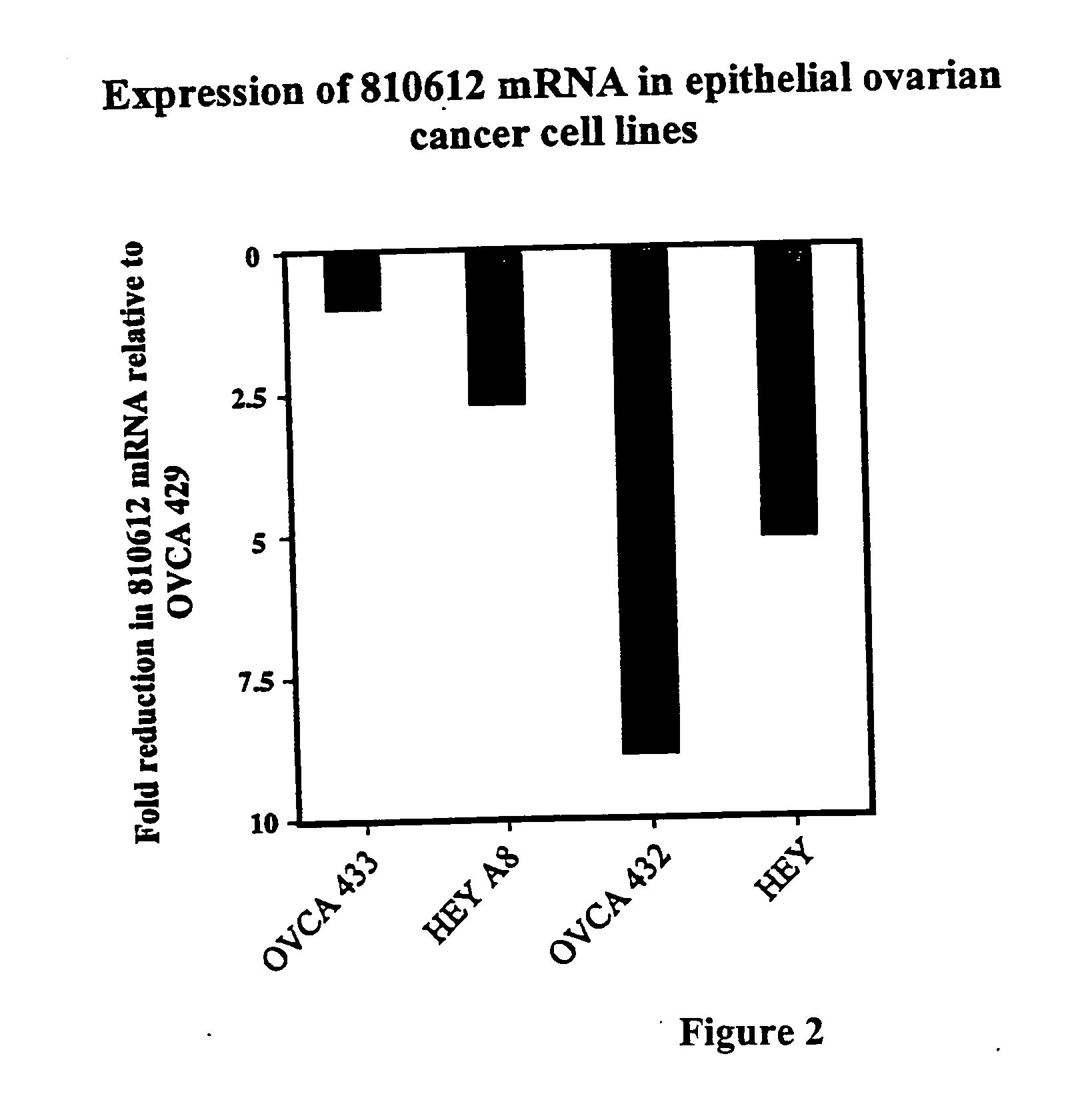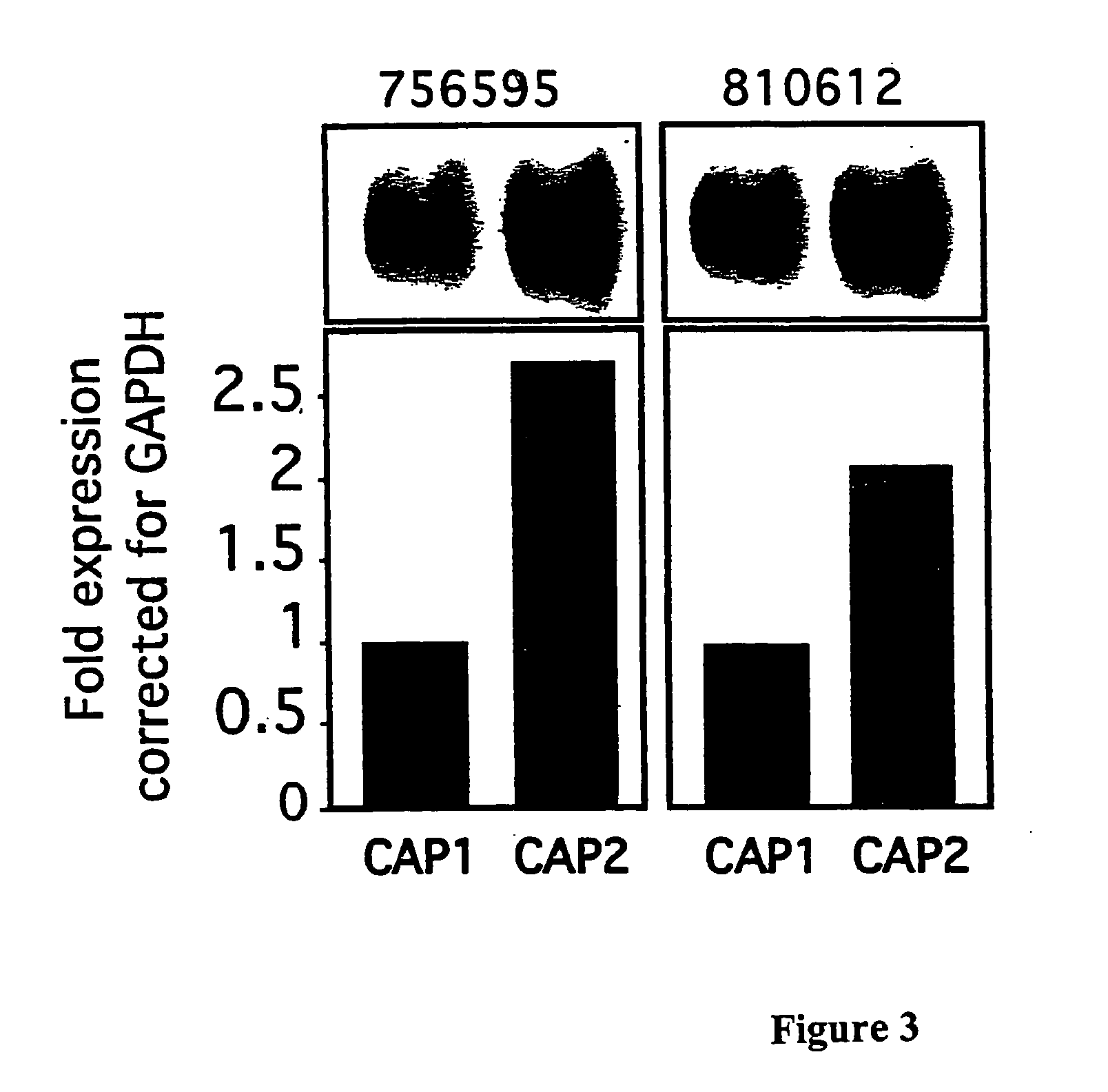Methods for predicting and overcoming resistance to chemotherapy in ovarian cancer and for predicting colon cancer occurrence
a technology of ovarian cancer and resistance to chemotherapy, which is applied in the direction of biocide, drug composition, peptide/protein ingredients, etc., can solve the problems of poor prognosis, low survival probability, and resistance to currently-available chemotherapeutic agents, and achieves the effect of improving survival rate and improving survival ra
- Summary
- Abstract
- Description
- Claims
- Application Information
AI Technical Summary
Benefits of technology
Problems solved by technology
Method used
Image
Examples
example 1
MTT Cell Proliferation Assays
[0150] Five ovarian cancer cell lines (OVCA 429, OVCA 433, OVCA 432, HEY and HEYA8) were ranked according to their levels of sensitivity to cis-platin using standard MTT cell proliferation assays.
[0151] Cells were grown in Minimal Eagle's Media (MEMα, obtained from Invitrogen Corp., Carlsbad, Calif.), 5% fetal bovine serum (FBS, heat inactivated), 1% antibiotic / antimycotic mixture (Invitrogen). The MTT stock solution (5 mg / mL; CALBIOCHEM, San Diego, Calif.) was prepared by dissolving dye in HBSS (Hank's Balanced Salt Solution), filtering said mixture and stored in 1 ml aliquots at −20° C. One ml of MTT stock was used for every 9 ml of media (total volume is 10 ml). Plates were covered with an opaque covering to protect the cells from light.
[0152] Each cell line was treated with 5, 25, 50, 100 and 200 μM cis-platin for 4, 8 and 24 hours. MTT assays were performed 96 hours after cis-platin treatment on 96 well plates. Media was removed from the cells a...
example 2
cDNA Micro Array, Northern Blot, and Quantitative Real-Time PCR Analysis
[0155] The cell lines characterized in Example 1 were used to perform micro-array analysis. Cell pellets were collected from each cell line and RNA was isolated from the cells by dissolving the pellets in 1 ml of TRI-Reagent (obtained from Molecular Research Center, Inc, Cincinnati, Ohio) or Trizol (Invitrogen). The samples were then allowed to sit for 5 minutes. Phase separation was accomplished by adding 100 μl of 1-bromo-3-chloropropane (BCP) to the sample. After shaking for 15 seconds, samples were incubated at room temperature for 15 minutes and then centrifuged for 16 minutes at 13,000 RCF at 4-25° C. The supernatant was removed by pipette and placed into a new microfuge tube. RNA was then precipitated by mixing the supernatant with 500 μl of fresh isopropanol, incubated at room temperature for 10 minutes, and centrifuged for 9 minutes at 13,000 RCF at 4-25° C. The supernatant was then removed from the t...
example 3
In Vitro Testing of SPARC as Therapeutic Target
[0203] SPARC was expressed at the highest levels in the most cis-platin resistant cell line (OVCA 429) compared to the other cell lines tested (FIG. 4). This protein is known in the art to be a calcium-binding glycoprotein that modulates adhesion and can play an important role in tissue remodeling and angiogenesis promoting tumor progression and invasiveness (Ledda et al., 1997, J. Invest. Dermatol. 108:210-214).
[0204] SPARC expression was tested in human Ascites fluid samples obtained from an individual before cyto-reductive surgery and then 9 months following surgery when the patient's tumor had recurred (FIG. 5; the two transcripts observed for SPARC arise due to differential polyadenylation; Ledda et al., 1997, J. Invest. Dermatol. 108:210-214). SPARC expression levels after surgery were greatly increased and correlated with a poor outcome for this patient. This observation was also consistent with findings made by other groups s...
PUM
| Property | Measurement | Unit |
|---|---|---|
| total volume | aaaaa | aaaaa |
| total volume | aaaaa | aaaaa |
| total volume | aaaaa | aaaaa |
Abstract
Description
Claims
Application Information
 Login to View More
Login to View More - R&D
- Intellectual Property
- Life Sciences
- Materials
- Tech Scout
- Unparalleled Data Quality
- Higher Quality Content
- 60% Fewer Hallucinations
Browse by: Latest US Patents, China's latest patents, Technical Efficacy Thesaurus, Application Domain, Technology Topic, Popular Technical Reports.
© 2025 PatSnap. All rights reserved.Legal|Privacy policy|Modern Slavery Act Transparency Statement|Sitemap|About US| Contact US: help@patsnap.com



